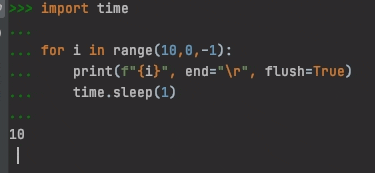显示python睡眠功能的倒计时
我在我的程序中使用time.sleep(10)。我运行程序时可以在shell中显示倒计时吗?
>>>run_my_program()
tasks done, now sleeping for 10 seconds
然后我想要它做10,9,8,7 ....
这可能吗?
10 个答案:
答案 0 :(得分:20)
你总能做到
#do some stuff
print 'tasks done, now sleeping for 10 seconds'
for i in xrange(10,0,-1):
time.sleep(1)
print i
这个片段有一些令人讨厌的功能,每个号码都会在换行符上打印出来。为避免这种情况,您可以
import sys
import time
for i in xrange(10,0,-1):
sys.stdout.write(str(i)+' ')
sys.stdout.flush()
time.sleep(1)
答案 1 :(得分:7)
您可以执行倒计时功能,例如:
import sys
import time
def countdown(t, step=1, msg='sleeping'): # in seconds
pad_str = ' ' * len('%d' % step)
for i in range(t, 0, -step):
print '%s for the next %d seconds %s\r' % (msg, i, pad_str),
sys.stdout.flush()
time.sleep(step)
print 'Done %s for %d seconds! %s' % (msg, t, pad_str)
回车\r和逗号,会使打印保持在同一行(每个倒计时值都避免一行)
随着秒数的减少,pad_str将确保最后一行被空格覆盖,而不是在输出缩短时留下最后一个字符。
最后一次打印用完成消息覆盖最后一条状态消息并递增输出行,因此有延迟的证据。
答案 2 :(得分:6)
这是在Python 3.x的控制台中显示计时器的最佳方法:
import time
import sys
for remaining in range(10, 0, -1):
sys.stdout.write("\r")
sys.stdout.write("{:2d} seconds remaining.".format(remaining))
sys.stdout.flush()
time.sleep(1)
sys.stdout.write("\rComplete! \n")
这会在每个循环中写入前一行。
答案 3 :(得分:2)
这是我在我的第一个python课程中学到的东西,我们玩过[" /"," - "," | "," \"," |"]但原则是相同的:
import time
for i in reversed(range(0, 10)):
time.sleep(1)
print "%s\r" %i,
答案 4 :(得分:1)
当然,只需编写一个打印10减去迭代计数器的循环,然后让它在每次迭代中休眠1秒并运行10次迭代。或者,更加灵活:
def printer(v):
print v
def countdown_timer(duration, step=1, output_function=printer,
prompt='Waiting {duration} seconds.'):
output_function(prompt.format(duration=duration))
for i in xrange(duration/step):
output_function(duration - step * i)
答案 5 :(得分:1)
这是我做的一个:
import time
a = input("How long is the countdown?")
while a != 0:
print a
time.sleep(1)
a = a-1
最后如果你和其他人你可以发出警报或其他什么。
答案 6 :(得分:1)
time.sleep()可能会提前返回。
为了提高多次迭代的准确性,为了避免大量迭代的漂移,倒计时可能会被时钟锁定:
#!/usr/bin/env python
import sys
import time
for i in reversed(range(1, 1001)):
time.sleep(1 - time.time() % 1) # sleep until a whole second boundary
sys.stderr.write('\r%4d' % i)
答案 7 :(得分:1)
从控制台清除最后一个数字的简单解决方案。
import time
for i in range(10,0,-1):
print(f"{i}", end="\r", flush=True)
time.sleep(1)
默认情况下,print 函数设置 end="\n",这意味着对 print 的后续调用将打印在新行上。您可以将其更改为 end=“\r” 以在每次调用 (https://www.codespeedy.com/how-does-carriage-return-work-in-python/) 后替换输出。
此外,使用 flush 意味着您不必担心缓冲问题 (What does print()'s `flush` do?)。
这是它的样子:
答案 8 :(得分:0)
这个是亚秒级的:
print()
_k = 0.5 # ensure k != _k first time round (as k will be integer)
print('Starting in ')
while _k > 0:
k = round(event_timestamp - time())
if k != _k:
print(f'\r{k} ', end='', flush=True)
_k = k
sleep(0.1)
print('boom')
注意 f'\r{k} ' 中的尾随空格。因此,如果我们从 100 转到 99 或从 10 转到 9,它会清除第二个数字。
它也不需要 import sys。
sleep(0.0003) 如果你想要毫秒精度。
答案 9 :(得分:0)
如果你不限制自己睡觉,那么(礼貌automatetheboringstuff),pyautogui 有一个漂亮的倒计时功能:
import pyautogui
print('Starting in ', end=''); pyautogui.countdown(3)
- 我写了这段代码,但我无法理解我的错误
- 我无法从一个代码实例的列表中删除 None 值,但我可以在另一个实例中。为什么它适用于一个细分市场而不适用于另一个细分市场?
- 是否有可能使 loadstring 不可能等于打印?卢阿
- java中的random.expovariate()
- Appscript 通过会议在 Google 日历中发送电子邮件和创建活动
- 为什么我的 Onclick 箭头功能在 React 中不起作用?
- 在此代码中是否有使用“this”的替代方法?
- 在 SQL Server 和 PostgreSQL 上查询,我如何从第一个表获得第二个表的可视化
- 每千个数字得到
- 更新了城市边界 KML 文件的来源?
